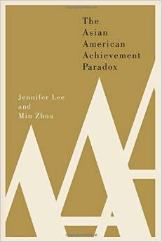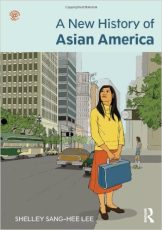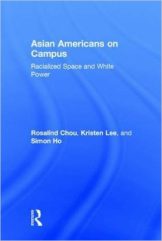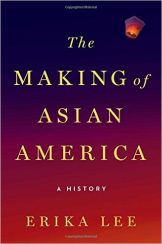January 20, 2016
Written by C.N.
New Books: Asian American History and Achievement
As the spring semester gets underway at many colleges and universities around the country, that means that new groups of students get their first introduction to Asian American Studies. With that in mind, these recently-published books provide some more details and sociological context about the history and contemporary dynamics of the Asian American community.
The Asian American Achievement Paradox, by Jennifer Lee and Min Zhou (Russell Sage Foundation)

Asian Americans are often stereotyped as the “model minority.” Their sizeable presence at elite universities and high household incomes have helped construct the narrative of Asian American “exceptionalism.” While many scholars and activists characterize this as a myth, pundits claim that Asian Americans’ educational attainment is the result of unique cultural values. In The Asian American Achievement Paradox, sociologists Jennifer Lee and Min Zhou offer a compelling account of the academic achievement of the children of Asian immigrants.
Drawing on in-depth interviews with the adult children of Chinese immigrants and Vietnamese refugees and survey data, Lee and Zhou bridge sociology and social psychology to explain how immigration laws, institutions, and culture interact to foster high achievement among certain Asian American groups. For the Chinese and Vietnamese in Los Angeles, Lee and Zhou find that the educational attainment of the second generation is strikingly similar, despite the vastly different socioeconomic profiles of their immigrant parents. Because immigration policies after 1965 favor individuals with higher levels of education and professional skills, many Asian immigrants are highly educated when they arrive in the United States.
They bring a specific “success frame,” which is strictly defined as earning a degree from an elite university and working in a high-status field. This success frame is reinforced in many local Asian communities, which make resources such as college preparation courses and tutoring available to group members, including their low-income members. While the success frame accounts for part of Asian Americans’ high rates of achievement, Lee and Zhou also find that institutions, such as public schools, are crucial in supporting the cycle of Asian American achievement. Teachers and guidance counselors, for example, who presume that Asian American students are smart, disciplined, and studious, provide them with extra help and steer them toward competitive academic programs.
These institutional advantages, in turn, lead to better academic performance and outcomes among Asian American students. Yet the expectations of high achievement come with a cost: the notion of Asian American success creates an “achievement paradox” in which Asian Americans who do not fit the success frame feel like failures or racial outliers. While pundits ascribe Asian American success to the assumed superior traits intrinsic to Asian culture, Lee and Zhou show how historical, cultural, and institutional elements work together to confer advantages to specific populations. An insightful counter to notions of culture based on stereotypes, The Asian American Achievement Paradox offers a deft and nuanced understanding how and why certain immigrant groups succeed.
A New History of Asian America, by Shelley Sang-Hee Lee (Routledge)

A New History of Asian America is a fresh and up-to-date history of Asians in the United States from the late eighteenth century to the present. Drawing on current scholarship, Shelley Lee brings forward the many strands of Asian American history, highlighting the distinctive nature of the Asian American experience while placing the narrative in the context of the major trajectories and turning points of U.S. history. Covering the history of Filipinos, Koreans, Asian Indians, and Southeast Indians as well as Chinese and Japanese, the book gives full attention to the diversity within Asian America.
A robust companion website features additional resources for students, including primary documents, a timeline, links, videos, and an image gallery. From the building of the transcontinental railroad to the celebrity of Jeremy Lin, people of Asian descent have been involved in and affected by the history of America. A New History of Asian America gives twenty-first-century students a clear, comprehensive, and contemporary introduction to this vital history.
Keywords for Asian American Studies, edited by Cathy J. Schlund-Vials, K. Scott Wong, and Linda Trinh Võ (NYU Press)

Born out of the Civil Rights and Third World Liberation movements of the 1960s and 1970s, Asian American Studies has grown significantly over the past four decades, both as a distinct field of inquiry and as a potent site of critique. Characterized by transnational, trans-Pacific, and trans-hemispheric considerations of race, ethnicity, migration, immigration, gender, sexuality, and class, this multidisciplinary field engages with a set of concepts profoundly shaped by past and present histories of racialization and social formation.
The keywords included in this collection are central to social sciences, humanities, and cultural studies and reflect the ways in which Asian American Studies has transformed scholarly discourses, research agendas, and pedagogical frameworks.Spanning multiple histories, numerous migrations, and diverse populations, Keywords for Asian American Studies reconsiders and recalibrates the ever-shifting borders of Asian American studies as a distinctly interdisciplinary field.
Asian Americans on Campus: Racialized Space and White Power, by Rosalind S. Chou, Kristen Lee, and Simon Ho (Routledge)

While there are books on racism in universities, few examine the unique position of Asian American undergraduates. This new book captures the voices and experiences of Asian Americans navigating the currents of race, gender, and sexuality as factors in how youth construct relationships and identities. Interviews with 70 Asian Americans on an elite American campus show how students negotiate the sexualized racism of a large institution. The authors emphasize the students’ resilience and their means of resistance for overcoming the impact of structural racism.
The Making of Asian America: A History, by Erika Lee (Simon & Schuster)

In the past fifty years, Asian Americans have helped change the face of America and are now the fastest growing group in the United States. But as award-winning historian Erika Lee reminds us, Asian Americans also have deep roots in the country. The Making of Asian America tells the little-known history of Asian Americans and their role in American life, from the arrival of the first Asians in the Americas to the present-day.
An epic history of global journeys and new beginnings, this book shows how generations of Asian immigrants and their American-born descendants have made and remade Asian American life in the United States: sailors who came on the first trans-Pacific ships in the 1500s; indentured “coolies” who worked alongside African slaves in the Caribbean; and Chinese, Japanese, Filipino, Korean, and South Asian immigrants who were recruited to work in the United States only to face massive racial discrimination, Asian exclusion laws, and for Japanese Americans, incarceration during World War II.
Over the past fifty years, a new Asian America has emerged out of community activism and the arrival of new immigrants and refugees. No longer a “despised minority,” Asian Americans are now held up as America’s “model minorities” in ways that reveal the complicated role that race still plays in the United States. Published to commemorate the fiftieth anniversary of the passage of the United States’ Immigration and Nationality Act of 1965 that has remade our “nation of immigrants,” this is a new and definitive history of Asian Americans. But more than that, it is a new way of understanding America itself, its complicated histories of race and immigration, and its place in the world today.

